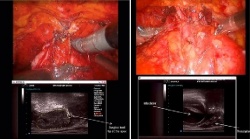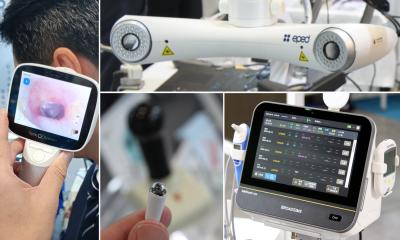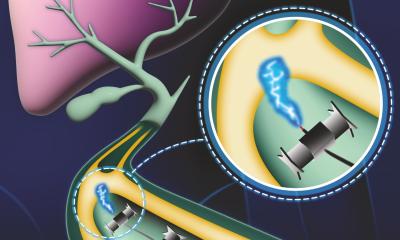Finally surgeons can look beneath the surface
Use of ultrasound for guidance is gaining ground, researchers explained during the 4th IPCAI, the International Conference on Information Processing in Computer-Assisted Interventions held during CARS 2013 in Heidelberg.

Right: Sagittal image of the prostate and bladder. Images courtesy of PhD student Omid Mohareri, who works with Professors Salcudean and Larry Goldenberg MD, head of Urologic Sciences at the University of British Columbia, who performed the surgery at Vancouver General Hospital
The technique has been shown to help increase precision in taking biopsies by percutaneous insertion of needles. Additionally, interest in guidance by ultrasound has increased in recent times with regard to enhancing surgical procedures, explained Professor Tim Salcudean from the University of British Columbia in Vancouver/Canada.
Integrating ultrasound with the da Vinci surgical robot is one of this expert’s key areas of interest: ‘The robot provides an easy way of coordinating the laparoscopic camera view with the ultrasound view,’ he explained. ‘Researchers look mostly into prostate surgery – in North America, 80 percent of these procedures are carried out by robots; that makes this application highly interesting.’ However, further potential areas of application, such as kidney surgery, keep coming up, he pointed out. What matters most is patient outcomes. The use of ultrasound may make the use of the surgical robot even more attractive, especially for novice surgeons, and can speed up procedures.
A better view of vessels and organ boundaries
Benefits researchers hope to derive from ultrasound guidance during procedures include visibility of vasculature and organ boundaries. ‘We also expect to improve the detection of cancer,’ Prof. Salcudean added. ‘Additionally, use of ultrasound technology should allow us to bring pre-operative images into the operating room: pre-operative MRI images can be superimposed, by using intra-operative ultrasound and ultrasound-MRI image registration, to provide augmented reality, enabling the surgeon to better decide on margins.’
The application of ultrasound guidance in the operating theatre (OT) is still restricted to a few centres because, he explained, an ultrasound technician is needed to set up the machine in the OT and position the transducer. Ultrasound is then manoeuvred remotely from the surgical console. ‘However, it’s a very uncommon situation for the surgeon – who is acting remotely – to work cooperatively with someone else,’ Prof. Salcudean pointed out. ‘Embracement of ultrasound guidance by surgeons using robots is therefore a difficult issue.’
It will also be important to progress regarding image processing to make them meaningful and easier for surgeons to understand. Furthermore, controlling ultrasound machines needs improvement, for example through various pre-sets and automatic adjustment. According to the Canadian expert, ‘these kinds of advances would help surgeons to use ultrasound guidance without a huge amount of training.’
Guidance as part of numerous ultrasound advances
So far, Prof. Salcudean’s University of British Columbia team has applied the technology to one animal and eight patients. However, that approach is part of a multi-faceted application of ultrasound, and guidance is becoming part of the bigger picture. ‘We’ve had many patients who have been imaged using that particular ultrasound system, and we’ve correlated tissue elasticity and viscosity with prostate cancer for 20 patients. We have also applied ultrasound to delineate the prostate in ultrasound images for radiation therapy for close to 40 patients. In those cases, by adding elasticity we’ve been able to improve the contrast-to-noise ratio in localising the prostate by a factor of five.’
Benefits make this an obvious trend
Ultrasound guidance allows surgeons to look beneath the surface of organs – this major benefit will support acceptance, Prof. Salcudean believes. The cost of ultrasound is reducing, and flexibility to programme the devices will help to increase ultrasound use in guidance. ‘My vision is that there will be applications in robotic surgery where easily accessible ultrasound guidance will be the standard method, similar to the embracement of the laparoscopic camera, for example.’
Profile:
Professor Tim Salcudean holds the C.A. Laszlo Chair and a Canada Research Chair at the University of British Columbia in Vancouver, Canada. He is interested in medical robotics, image guidance and imaging the mechanical properties of tissue, with applications particularly in urology and prostate cancer.
16.09.2013











